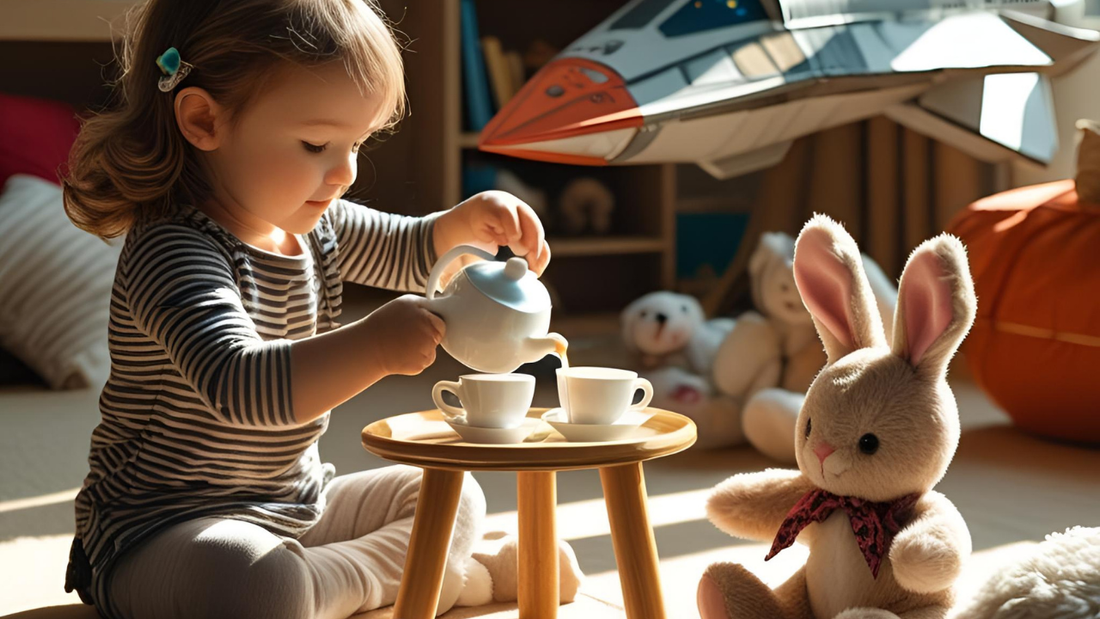
Pretend Play for Toddlers: Why It Matters and How to Start
LiLLBUDIf you’ve ever watched your toddler pour invisible tea into tiny cups or tuck a teddy bear in for bed with a very serious "Shhh!", you’ve witnessed pretend play in action. It might look like adorable nonsense-but to your child, it’s deep, important work.
From role-play to storytelling, pretend play for toddlers is a powerful tool for learning. It helps little ones in exploring emotions, problem-solving, and making sense of their world - without them even realizing it. It’s not just about play – it’s about growth.
Let’s dive into why this kind of play is important and how you can nurture it with simple tools such as soft toys, household items, and your child’s own wild imagination.
What Is Pretend Play, Really?
Pretend play (also referred as imaginative games or make-believe) is when toddlers use their imagination to create stories, roles, and situations that are not based on reality. It might be:
- Feeding a doll
- Talking into a pretend banana phone
- Pretending to be a doctor, chef, or superhero
-
Giving a stuffed animal a full-blown bedtime routine
In these tiny gestures, an big developmental leap is occurring.
Why Pretend Play Matters for Baby Development Milestones
Toddlers between 1.5 and 3 years old are crossing important baby development milestones. Pretend play supports multiple of them at once:
1. Language Development
Toddlers narrate, describe, and converse for their toys, increasing vocabulary and sentence abilities.
2. Emotional Growth
Through role-playing various emotions, toddlers develop empathy and learn to process feelings.
3. Problem-Solving
When a doll "won't sleep" or there are no cups at the tea party, children learn to improvise. That's flexible thinking in action!
4. Social Skills
Even solo play includes back-and-forth "conversations." Playing with you or another child develops turn-taking, sharing, and cooperation.
5. Motor Skills
Dressing up dolls, building pretend castles with stacking cups, or stirring pretend soup? That’s fine motor skill practice, another key baby milestone.
How to Encourage Pretend Play at Home
Here’s the best part: With just a few open-ended toys and a bit of time, your toddler’s imagination will turn simple moments into full-blown pretend adventures.
1. Follow Their Lead (aka: Child-Led Play)
Watch what your child is already interested in – a doll, a kitchen set, animals – and build around it. Allow child-led play guide the flow. If they’d like to be the doctor and you’re the patient? Let it happen!
Pro tip: Toddlers love repeating scenarios they observe in everyday life. Bedtime routines, cooking, grocery shopping – all are play goldmines!
2. Use Soft Toys as “Characters”
Teddy bears, plush toys, or cloth dolls become best friends, babies, pets, and patients. Soft toys provide toddlers with a reassuring, comforting starting point to role-playing and storytelling.
Try: Naming the soft toy, assigning it a job, or giving it a special little blanket to sleep with – it’ll spark ideas.
3. Repurpose Household Items
Empty containers become mixing bowls, a scarf becomes a cape, and a cardboard box? That’s a spaceship, of course.
No-cost pretend play is often the most creative. And yes, it buys you at least 10 minutes of solo coffee time.
4. Celebrate Milestones with Role-Play
Pretend play can be a beautiful way to reinforce and celebrate baby milestones. For example:
-
Role-play “first steps” with a doll
-
Feed a toy just like your toddler is learning to self-feed
- Pretend to attend school or a doctor's appointment as your toddler gets closer to those real-life experiences
Snap a photo with your baby milestone cards beside the play scene – it becomes a memory and a celebration of growth.
5. Build a Mini Pretend Play Kit
A small basket with:
-
A few soft toys
-
A spoon or cup
-
A doctor badge
-
A few fabric scraps or scarves
That’s all you need to spark hours of imaginative games. Rotate items weekly to keep the curiosity fresh!
Bonus Ideas for Pretend Play Toddlers Will Love
- Grocery Store: Use pantry items and a shopping bag
- Bedtime Routine: Pajamas, bedtime songs, and goodnight kisses for a doll
- Chef's Kitchen: Soup time with dry pasta and safe utensils
- Car Wash: Clean toy cars with a sponge and some water (perfect for backyard play!)
- Vet Visit: Use bandages and cotton balls to "treat" for stuffed animals
Pretend Play Is Real Growth
It might seem like your toddler is just playing tea party or building a dragon cave out of pillows – but beneath the giggles and costumes, their brain is developing in magical ways. Pretend play is where imagination meets confidence, and milestones meet memories.
So go ahead—sip the invisible tea, get "sick" so your toddler can heal you, and cheer when Teddy finally eats his broccoli. These little moments are where big learning begins.
And remember: in their world, a stuffed animal can save the day. So can you.

